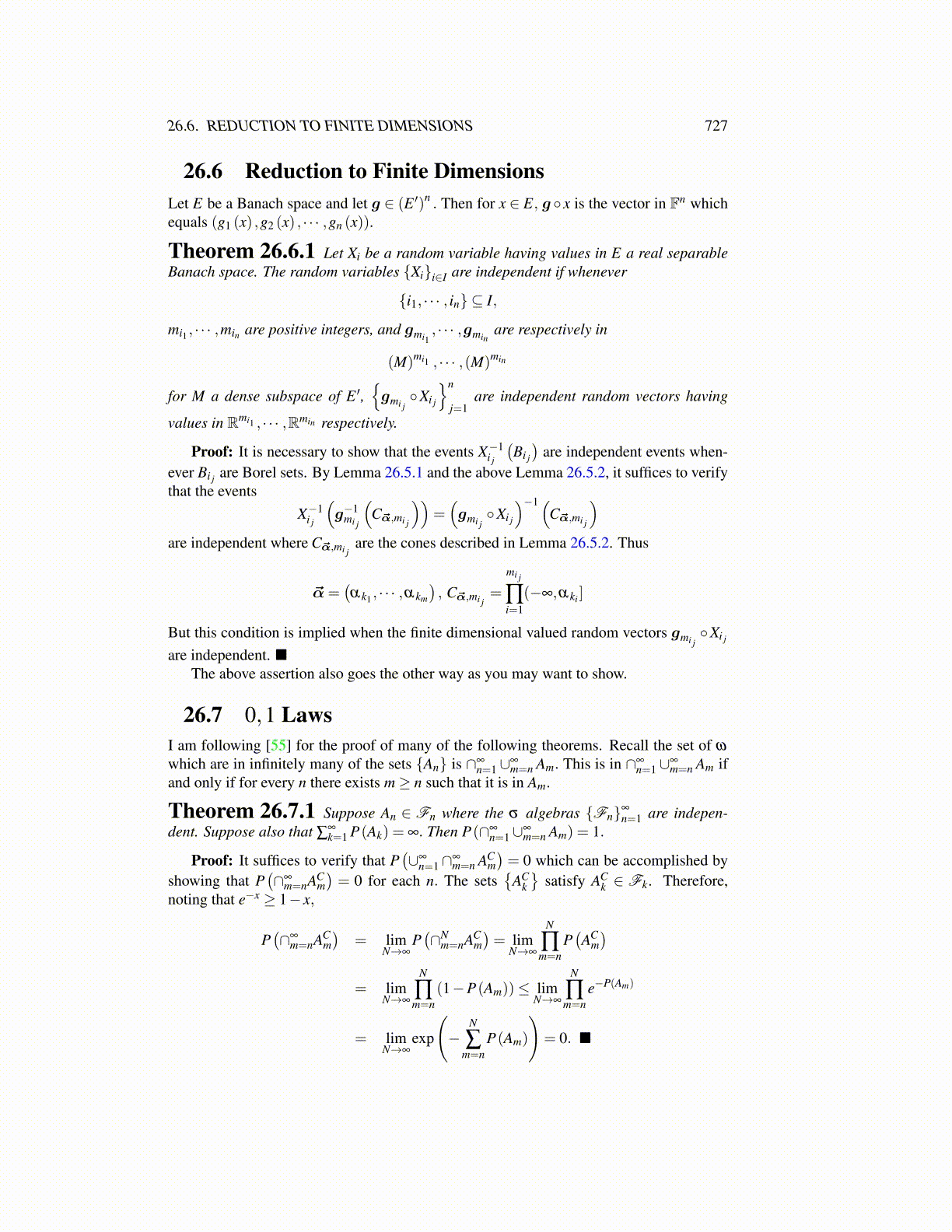
26.6. REDUCTION TO FINITE DIMENSIONS 727
26.6 Reduction to Finite DimensionsLet E be a Banach space and let g ∈ (E ′)n . Then for x ∈ E, g ◦ x is the vector in Fn whichequals (g1 (x) ,g2 (x) , · · · ,gn (x)).
Theorem 26.6.1 Let Xi be a random variable having values in E a real separableBanach space. The random variables {Xi}i∈I are independent if whenever
{i1, · · · , in} ⊆ I,
mi1 , · · · ,min are positive integers, and gmi1, · · · ,gmin
are respectively in
(M)mi1 , · · · ,(M)min
for M a dense subspace of E ′,{gmi j◦Xi j
}n
j=1are independent random vectors having
values in Rmi1 , · · · ,Rmin respectively.
Proof: It is necessary to show that the events X−1i j
(Bi j
)are independent events when-
ever Bi j are Borel sets. By Lemma 26.5.1 and the above Lemma 26.5.2, it suffices to verifythat the events
X−1i j
(g−1
mi j
(Cα⃗,mi j
))=(gmi j◦Xi j
)−1(Cα⃗,mi j
)are independent where Cα⃗,mi j
are the cones described in Lemma 26.5.2. Thus
α⃗=(αk1 , · · · ,αkm
), Cα⃗,mi j
=
mi j
∏i=1
(−∞,αki ]
But this condition is implied when the finite dimensional valued random vectors gmi j◦Xi j
are independent. ■The above assertion also goes the other way as you may want to show.
26.7 0,1 LawsI am following [55] for the proof of many of the following theorems. Recall the set of ω
which are in infinitely many of the sets {An} is ∩∞n=1∪∞
m=n Am. This is in ∩∞n=1∪∞
m=n Am ifand only if for every n there exists m≥ n such that it is in Am.
Theorem 26.7.1 Suppose An ∈ Fn where the σ algebras {Fn}∞
n=1 are indepen-dent. Suppose also that ∑
∞k=1 P(Ak) = ∞. Then P(∩∞
n=1∪∞m=n Am) = 1.
Proof: It suffices to verify that P(∪∞
n=1∩∞m=n AC
m)= 0 which can be accomplished by
showing that P(∩∞
m=nACm)= 0 for each n. The sets
{AC
k
}satisfy AC
k ∈ Fk. Therefore,noting that e−x ≥ 1− x,
P(∩∞
m=nACm)
= limN→∞
P(∩N
m=nACm)= lim
N→∞
N
∏m=n
P(AC
m)
= limN→∞
N
∏m=n
(1−P(Am))≤ limN→∞
N
∏m=n
e−P(Am)
= limN→∞
exp
(−
N
∑m=n
P(Am)
)= 0. ■